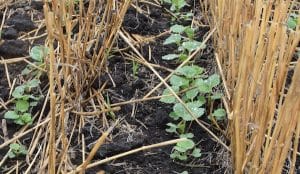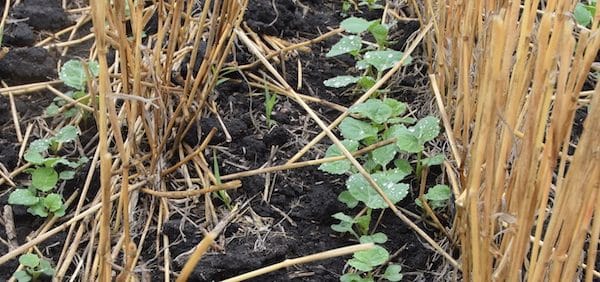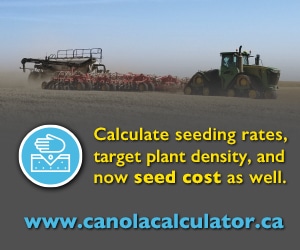The percentage of canola seeds that emerge to form plants in the spring is typically in the range of 50 to 60 per cent, but there are instances where growers have achieved 90 per cent emergence. All growers should know their average canola emergence and try to improve it. Striving for 75 per cent emergence is an ambitious target that will give each seed a better chance to contribute to the crop’s yield and profitability.
If a canola farmer spends $60 per acre on seed, the difference between 50 per cent and 75 per cent emergence can be an immediate $15-per-acre increase in the value contribution of that seed investment. But that’s only the beginning. Yield potential and predictability drop off with stands of fewer than four plants per square foot – which is why the Canola Council of Canada recommends a target of five to eight plants per square foot. With higher emergence rates, canola crops are more likely to achieve this target stand and protect their yield potential.
Thick, uniform stands also canopy more quickly, making them less likely to require a second in-crop herbicide application and in-season flea beetle control.

How to improve emergence percentage
Common factors that decrease canola seed and seedling survival are environmental (too dry, too cold, too wet), abiotic (poor seed placement or seed/soil contact, excess seed-placed fertilizer), and biotic (insects and disease).
Here are some steps to manage those factors that you can control:
Seed shallow. Half an inch to one inch below the packer furrow is the recommended seed depth for canola. This will reduce days to emergence and reduce the seed energy required for emergence. Read the Canola Digest Science Edition summary of recent research.
Seed at a consistent depth. For some drills, the overall average may be one inch, but the range could be zero to two inches. The result can be highly variable emergence dates and an uneven field. Follow the operator’s manuals to level the drill, check that openers are in good shape and inflate tires to the same pressure. This PODCAST provides some useful tips to make sure the seeding tool is level.
Seed slower. In general, at higher speeds, rear openers tend to throw more soil over the front rows, making these seeds slower to emerge. At higher speeds, the whole seeding tool is less likely to cut smooth, even seed rows.
Limit seed-placed fertilizer. Seed-placed fertilizer can increase seedling mortality. The safest practice is to place only phosphate fertilizer with the seed at rates up to 20 pounds of phosphate per acre. Higher soil moisture will protect seedlings somewhat from higher rates. Read the Canola Encyclopedia chapter on safe seed-placed fertilizer.
Penetrate residue. Use openers and drill settings to penetrate residue so all seeds go into the soil. Residue should be spread evenly across the soil surface during or after harvest the fall before seeding canola.
Pack appropriately. In wet conditions, reduce packing pressure to limit hard crusting. In dry conditions, pack more to conserve moisture in the seed row and ensure adequate seed-to-soil contact.
Seed into warmer soils. Soil temperatures of 5°C or higher with warmer weather in the forecast should facilitate reasonably good rates of emergence. The clock starts running on seed treatments as soon as the seed takes in water and begins germinating, so rapid emergence means that there will be a bigger window of protection from flea beetle for above ground growth.
Rotate crops. A tight canola rotation could increase the risk from seed and seedling diseases that can prevent emergence or weaken the young plants.
You don’t know what you don’t measure
The Canola Council of Canada encourages growers and agronomists to take steps this year to improve seed survival. Count plants in each field at around the two- to four-leaf stage, by which time all that will contribute to yield have emerged. Enter plant density, seeding rate and TSW for each field into the emergence calculator at www.canolacalculator.ca and record the result for each field. Was it below, above or right at the estimated emergence before seeding? What can be done to me the 75% (or higher) goal? CCC agronomy specialist Autumn Barnes explains how to use the calculator in this video.


